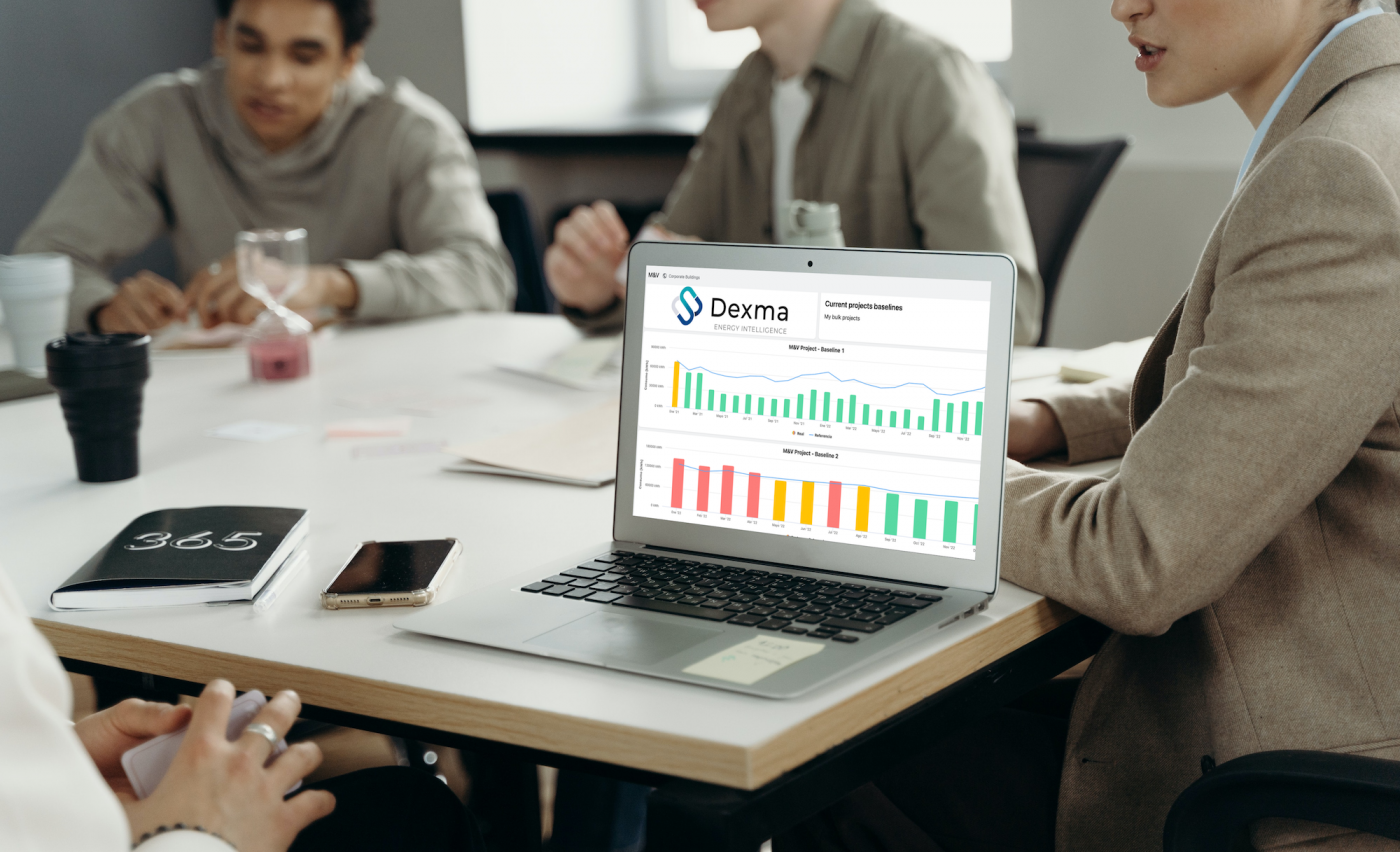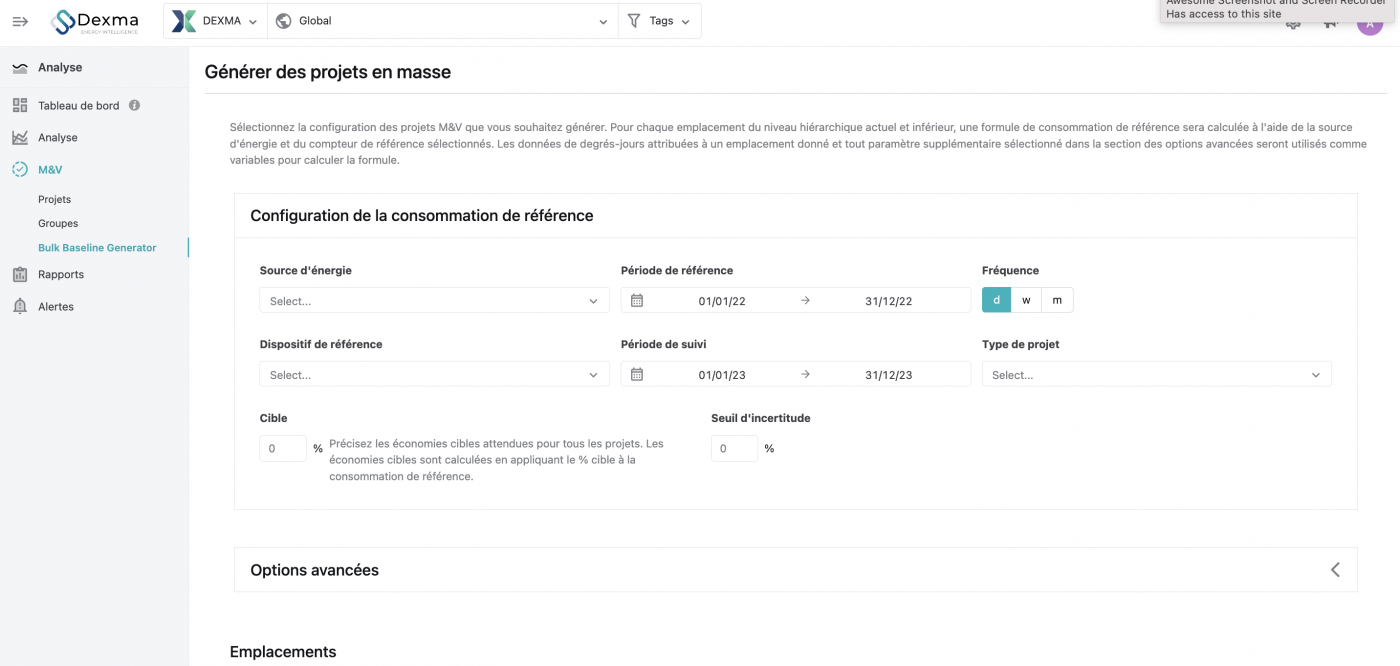If you manage a large portfolio of buildings, you might be wondering how to define an accurate baseline for each one. A baseline helps you track energy use and set goals for reducing consumption.
But if you are still manually generating baselines for each building, it can be a time-consuming and error-prone process. Fortunately, there is a better way: you can now automatically generate baselines for your entire building portfolio using Dexma’s Bulk Baseline Generator.
In this blog post, we will show you why it is important to automatically generate baselines for your buildings to start saving energy and how to do it using Dexma’s Bulk Baseline Generator.
Why is it important to have a Baseline Model?
A baseline model is a formula that explains a building’s consumption against which you can measure progress or results. It represents your building’s energy consumption over a set period of time, usually one year.
By comparing your building’s real consumption to its baseline consumption, you can see how your building is performing over time. Replicate this through your portfolio and you can track the energy savings across all your organisation.
There are many reasons why it’s important to have a baseline:
1) Baseline models help you track progress toward energy reduction goals. If you are trying to reduce your energy use by 10% over the next year, having a baseline will allow you to see if you’re on track to reach that goal.
2) Baseline models can take into account the context variables of your building that can influence energy consumption such as external temperature, degree days data, occupancy, and production… Using these variables in the model will augment its accuracy compared to using the previous year’s consumption.
3) Baseline models can adapt to the situation of your building: if the normal operation of your building is altered in any way (after-hours event, maintenance works…) that can influence energy consumption, your baseline can reflect this so that you can still track your savings accurately.
There are many other reasons we could think of, but these are just a few of the most important ones. In short, having a baseline is essential for any serious effort to improve energy efficiency.
What does it take to create a good Baseline Consumption Model?
You will need at least one year of historical data to take into account seasonality for the building consumption and for any variable that might influence it such as temperature, degree days, occupancy, and production…
The most important variables are:
- Temperature: The heating (or cooling) demand is strongly influenced by the ambient temperature. For example, if it is cold outside, more energy will be required for heating purposes; conversely, if it’s hot outside more energy will be required for cooling purposes. The weather forecast can give you an indication of how much heating/cooling demand may occur during different seasons or weather conditions.
- Degree Days: Degree Days are defined as the number of degrees Celsius above or below a fixed base temperature. They indicate how much heating or cooling is needed over time in order to reach thermal comfort inside buildings. They are automatically calculated in Dexma.
Why you should automatically generate Baselines for your entire Building Portfolio:
Traditionally a baseline is calculated using a spreadsheet and or other specialised statistical tools, to perform multiple linear regression calculations. However, using this method, it can take you hours to obtain a valid baseline model for a single building.
Using Dexma’s Bulk Baseline Generator, you can obtain a baseline formula and create a Measure & Verification to compare that baseline consumption with your building’s real consumption with just a few clicks. And it will do it for every building in your portfolio, not just one.
How to Automatically generate Baselines for your entire Building Portfolio
In order to automatically generate a baseline, you will first need to gather data on your building’s energy use. This data can come from a variety of sources, including utility bills, fiscal metres, IoT devices and sub-metres. Once you have this data, you will need to feed it into an energy management software such as Dexma Analyse, which can process data from all these sources automatically.
Once you have your data in Dexma you can run the Bulk Baseline Generator to start generating baseline models and their linked measure and verification project with a few clicks.
By selecting the energy source, periods, and reference device type, you can start generating baselines for each building.
The baselines will be created using energy consumption data as well as degree days or temperature data linked to each building.
Tracking Energy Savings with the generated Baseline
Once the baseline models are calculated you can use an energy management software with a measure and verification module in order to track your savings.
Measurement and verification (M&V) is used to verify the energy savings that were achieved in an energy efficiency project.
Dexma’s M&V Projects are compatible with the IPMVP protocol and allow you to track Energy Performance Contracts.
With the baseline defined and the M&V Project configured, you can start tracking your savings and increasing the efficiency of your buildings.
A baseline is an important tool for any building portfolio manager. It provides a point of reference against which you can measure progress and identify areas of improvement. By automatically generating baselines, you can save time and ensure that your entire portfolio is covered.
There are a few things to keep in mind when automatically generating baselines: you need to have accurate data for your buildings and you should also keep an eye on factors that could affect your baseline, such as weather conditions or changes in occupancy levels.
By following these tips, you can create a good baseline model for each of your buildings and use them to effectively track savings across your building portfolio. Don’t hesitate to get in touch with our Energy Experts to discuss how implementing an Energy Management System can benefit your company!
Ready to unlock the full potential of Measurement and Verification? You can now watch the recording of this webinar! Find out how to get the best results in your Energy Savings Verification Projects! In this 30’ video, you will learn how to get the best results in your Energy Savings Verification Projects.
Editor’s note – This article was written by our Product Expert


![Unlock the full potential of Measurement and Verification [Webinar]](https://no-cache.hubspot.com/cta/default/437281/da8d9417-3eda-440d-9236-bef22eb0b5e0.png)

![Unlock the full potential of Measurement and Verification [Webinar]](https://no-cache.hubspot.com/cta/default/437281/b2860387-43cf-43c1-83c0-fcd500e97957.png)

